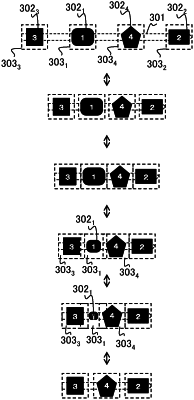| CPC G09G 5/377 (2013.01) [G06F 3/0481 (2013.01); G06F 3/04886 (2013.01); G09G 5/373 (2013.01); G09G 2340/04 (2013.01); G09G 2380/10 (2013.01)] | 10 Claims |

|
1. A display control device comprising:
a memory; and
a processor communicatively coupled to the memory,
wherein the processor is configured to:
change a size of a first display region from among a plurality of display regions provided on a screen by changing a position of a boundary line that defines an extent of the first display region among the plurality of the display regions,
set a respective collision determination region that surrounds each respective display object among a plurality of display objects, and
in response to the change in the size of the first display region:
change a size of an arrangement region provided in the first display region,
set a relative priority of each of the plurality of display objects that are arranged in the arrangement region, and
display the plurality of display objects on the screen based on the relative priority,
wherein on a condition that the change of the size of the first display region results in a smaller size of the arrangement region, the processor is configured to:
determine a first display object having a lowest priority amongst the plurality of display objects displayed in the arrangement region based on the relative priority,
reduce an interval between the first display object and a second display object that is adjacent to the first display object amongst the plurality of display objects,
determine a degree of overlapping between the respective collision determination region of the first display object and the respective collision determination region of the second display object,
when the degree of overlapping is equal to or greater than a first predetermined threshold, reduce a size of the first display object from among the plurality of display objects, and
when the degree of overlapping is equal to or greater than a second predetermined threshold value, eliminate the first display object from being visible among the plurality of display objects that are displayed on the screen.
|